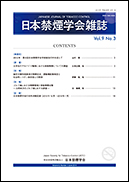Aim: The purpose of this study was to explore the relationship between self-efficacy and continuation of smoking cessation among outpatients visiting a clinic for smoking cessation over the 12 weeks treatment period.
Methods: Data was collected for 81 outpatients who provided consent between July and November 2013. The data collected included the following: motive for and confidence in smoking cessation, as well as selfefficacy at the first visit, treatment contents such as the number of a clinic visits, and the status of continuation of smoking cessation after 12 weeks. Relationships to confidence in smoking cessation and self-efficacy were analyzed between the smoking cessation continuation and non-continuation groups.
Results: A total of 44 individuals (54.3%) had continued smoking cessation. Compared to the non-continuation group, the smoking cessation continuation group had a significantly higher proportion of outpatients responded “wanted more strongly than before to quit smoking” of their motive for smoking cessation. Also, the group had a significantly higher proportion of outpatients who had more than five visits of a clinic and a significantly higher median score for the "anxiety about failure" on the subscale of self-efficacy.
Discussion: Outpatients assessment in motives for smoking cessation and self-efficacy at initial visit was considered useful for support for continuation of smoking cessation.
Conclusion: Outpatients who continued smoking cessation 12 weeks after the start of this program was approximately 50%. For the smoking cessation continuation of outpatients, it was useful to promote a routine visit to a clinic and to support of improving their self-efficacy.
View full abstract
